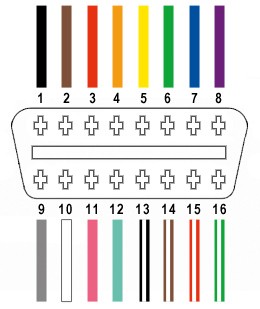Building your own OBD2 connector might seem daunting, but with the right guidance and a bit of DIY spirit, it’s absolutely achievable. This guide will walk you through the process of wiring an OBD2 connector, perfect for custom projects or repairs.
Disclaimer: This is a DIY guide for informational purposes. I am not a professional mechanic. Follow these steps at your own risk. I am not responsible for any damage to your vehicle, ECU, or any unforeseen consequences. If you are not comfortable with electrical work, please consult a professional.
Tools and Parts You’ll Need
Before you start, gather these essential tools and parts:
- Wire strippers/cutters: For preparing the wires.
- Needle-nose pliers: Helpful for handling small components.
- Molex crimping tool (optional but recommended): For securely crimping connector pins.
- Soldering iron (recommended): For a more robust and reliable connection.
- 4-Pin Connector: (Corsa Technic – 4-Pin Connector; pin/wire size = 22-16AWG; insulation/seal size = 1.3-1.7mm)
- OBD-II Cable: (Corsa Technic – OBD-II Cable)
If you have spare wires, you can purchase just the female OBD-II connector and wire it directly, saving a bit on cost. Ensure your wire gauge is compatible with the 4-pin connector you choose.
Understanding OBD2 Connector Wiring
The OBD2 connector, or OBDII connector, has 16 pins, but for many basic applications, we only need to focus on four key wires for CAN communication and power:
- Pin 4: Chassis Ground (Orange wire in the specified OBD2 cable)
- Pin 6: CAN High (J-2234) (Green wire in the specified OBD2 cable)
- Pin 14: CAN Low (J-2234) (Brown w/white stripe wire in the specified OBD2 cable)
- Pin 16: Battery Power (Green w/white stripe wire in the specified OBD2 cable)
Step-by-Step Guide to OBD2 Connector Wiring
Let’s get started with the wiring process.
Step 1: Preparing the OBD-II Cable Wires
- Expose the Wires: Carefully remove the outer sheath and shielding from the OBD-II cable to access the individual wires.
- Separate the Necessary Wires: Isolate the four wires we’ll be using: Pin 4 (Orange), Pin 6 (Green), Pin 14 (Brown w/white stripe), and Pin 16 (Green w/white stripe).
- Organize Remaining Wires: Bundle the remaining 12 wires and secure them with a zip tie to keep them out of the way.
Step 2: Preparing the 4-Pin Connector Pins
- Wire Thickness Adjustment: The wires in the OBD-II cable are typically 26AWG, which is thinner than the 22AWG minimum recommended for the 4-pin connector pins. To compensate:
- Strip approximately 3/8″ of insulation from the end of each of the four wires.
- Fold the exposed wire strands over and twist them tightly to effectively thicken the wire gauge, ensuring a better fit in the connector pins.
- Rubber Seals: Slide one rubber seal from the 4-pin connector kit onto each of the prepared wires. These seals provide environmental protection for the connection.
Step 3: Soldering or Crimping the Wires to the Pins
- Pin Positioning: Each pin for the 4-pin connector has two sets of prongs. The front prongs are for securing the wire, and the rear prongs are for the rubber seal. Insert the exposed wire into the front section of the pin, ensuring it aligns with the front prongs.
- Soldering (Recommended): For a strong and conductive connection, soldering is highly recommended, especially given the thin gauge of the OBD-II cable wires. Solder the wire to the pin, ensuring a solid bond. If you’re new to soldering, resources like this YouTube video can be helpful.
- Crimping (Alternative): If you have a Molex crimping tool, you can crimp the front prongs around the wire. If not, needle-nose pliers can be carefully used to fold the prongs over the wire. Ensure a tight crimp for good electrical contact.
Step 4: Crimping the Seal and Assembling the 4-Pin Connector
- Seal Crimping: Slide the rubber seal up to the rear prongs of the pin. Use the crimping tool or needle-nose pliers to fold the rear prongs over the seal, securing it in place and providing strain relief and environmental protection.
- Connector Assembly: Refer to the 4-pin connector diagram and insert the pins into the correct slots in the connector housing from the rear until they click into place. The pin assignments are as follows:
- Pin 14 (Brown w/white stripe) > Connector Slot A
- Pin 6 (Green) > Connector Slot B
- Pin 16 (Green w/white stripe) > Connector Slot C
- Pin 4 (Orange) > Connector Slot D
Step 5: Final Assembly and Testing
- Wire Pairing and Twisting (Optional): Some guides recommend twisting wire pairs for potential noise reduction. You can optionally twist the following pairs:
- Pin 4 (Orange) / Pin 16 (Green w/white stripe)
- Pin 6 (Green) / Pin 14 (Brown w/white stripe)
- Insert Pins into Connector Housing: Insert each pin into its designated slot in the 4-pin connector housing until you hear a click, indicating it’s securely locked. Use needle-nose pliers to gently pull the wire from the front to ensure the pin is locked in place.
Conclusion
Congratulations! You have now successfully wired your own OBD2 connector. This DIY OBD2 connector can be used for various projects, such as connecting aftermarket diagnostic tools or creating custom wiring setups.
Remember to double-check your wiring and pin assignments before connecting to your vehicle. If you are unsure about any step, consult with a qualified automotive electrician.
This DIY guide provides a basic understanding of Obd2 Connector Wiring. Always exercise caution and prioritize safety when working with automotive electronics.

